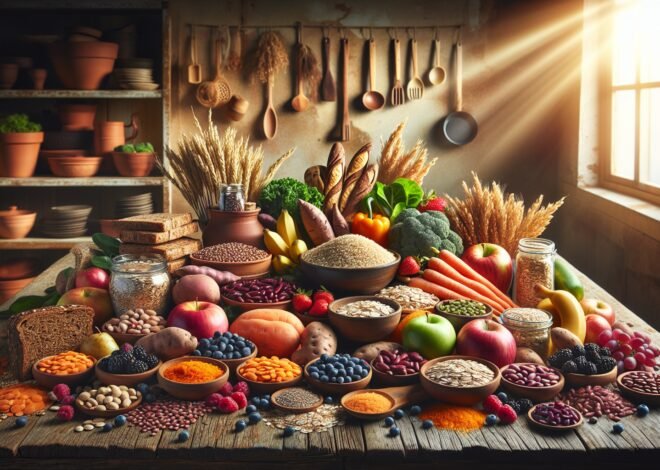
The Role of Fiber in a Balanced Diet and How to Get Enough
Fiber in a balanced diet is essential for maintaining optimal health and wellness. Surprisingly, up to 95% of adults and children in the U.S. do not get enough fiber in their daily meals. This dietary component supports digestive health, regulates blood sugar levels, and aids in weight management. Yet, many people overlook its importance. This post will delve into the essential role of fiber in a balanced diet, offering practical tips on how to incorporate more fiber-rich foods into your daily meals. Understanding its impact can empower you to make informed nutritional choices for a healthier lifestyle.
Understanding the Importance of Dietary Fiber in Nutrition
Dietary fiber plays a crucial role in maintaining overall health. It’s more than just a digestive aid; it’s a key component of a balanced diet that supports various bodily functions. From improving gut health to reducing the risk of chronic diseases, fiber is essential for everyone. Let’s explore the different types of fiber and their health benefits, along with the recommended daily intake for various age groups.
Types of Dietary Fiber: Soluble vs. Insoluble
Dietary fiber can be categorized into two main types: soluble and insoluble. Each type offers unique benefits. Soluble fiber dissolves in water and forms a gel-like substance in the gut. It can help lower blood cholesterol and glucose levels. Foods rich in soluble fiber include oats, beans, lentils, apples, and citrus fruits.
In contrast, insoluble fiber does not dissolve in water. It adds bulk to the stool and aids in quicker passage through the digestive tract. This helps prevent constipation. Whole grains, nuts, beans, and vegetables like cauliflower and potatoes are excellent sources of insoluble fiber. Both types of fiber are important for maintaining good health and should be included in your daily diet.
Health Benefits Associated with High-Fiber Diets
A diet high in fiber offers numerous health benefits. It supports digestive health by preventing constipation and promoting regular bowel movements. Fiber can also play a role in weight management. It helps you feel full longer, reducing the likelihood of overeating. High-fiber diets are linked to a lower risk of developing chronic diseases such as heart disease, type 2 diabetes, and colorectal cancer.
Additionally, fiber can improve cholesterol levels and help control blood sugar levels. This is particularly beneficial for individuals with diabetes. By stabilizing blood sugar, fiber helps reduce the risk of diabetes-related complications. Furthermore, fiber-rich foods often contain essential nutrients, making them an integral part of a healthy diet.
Recommended Daily Intake of Fiber for Different Age Groups
The recommended daily intake of fiber varies by age, sex, and life stage. For adults, the general guideline is 25 grams per day for women and 38 grams per day for men. These amounts decrease to 21 grams for women and 30 grams for men over the age of 50. Children also require fiber, with recommendations starting at 19 grams for toddlers and increasing with age.
Pregnant or lactating women should aim to consume 28 grams of fiber daily to support their health and the health of their baby. It’s important to gradually increase fiber intake to avoid gastrointestinal discomfort. Incorporating a variety of fiber-rich foods ensures a balanced intake of both soluble and insoluble fibers.
Sources of Fiber-Rich Foods and How to Incorporate Them
Finding delicious and satisfying sources of fiber is key to meeting daily requirements. Fiber-rich foods are not only healthy but also versatile, allowing you to incorporate them into any meal. From fruits and vegetables to whole grains and legumes, there are plenty of options to enhance your diet. Discover how these foods can become staples in your daily meals.
Top Vegetables and Fruits High in Fiber
Vegetables and fruits are among the best sources of dietary fiber. They provide essential vitamins, minerals, and antioxidants along with fiber. Some top fiber-rich vegetables include broccoli, Brussels sprouts, carrots, and artichokes. Leafy greens like spinach and kale also contain fiber.
Fruits rich in fiber include pears, apples, berries, and bananas. Dried fruits such as figs and prunes are concentrated sources of fiber. Incorporating a variety of these foods into your diet ensures you get both soluble and insoluble fiber. Try adding them to salads, smoothies, or as snacks to boost fiber intake.
Whole Grains and Legumes as Fiber Powerhouses
Whole grains and legumes are excellent sources of fiber, protein, and vital nutrients. Whole grains like oats, quinoa, barley, and brown rice retain their bran and germ, providing more fiber than refined grains. Whole grain bread, pasta, and cereals are also great choices.
Legumes, including beans, lentils, chickpeas, and peas, are fiber-rich and versatile. They’re an ideal addition to soups, stews, salads, and more. They offer a plant-based protein source, making them an essential part of vegetarian and vegan diets. Incorporate these foods to enjoy their numerous health benefits.
Creative Ways to Add Fiber to Every Meal
Adding fiber to your meals doesn’t have to be difficult. Simple swaps and additions can make a big difference. Start your day with a bowl of oatmeal topped with fruits and nuts. Choose whole grain bread for sandwiches and include vegetables like lettuce and tomatoes.
Adding beans or lentils to soups and casseroles boosts fiber content. Use whole grain pasta and add a variety of vegetables to sauces. Snack on nuts, seeds, or popcorn for a fiber-rich treat. With a little creativity, you can easily increase your fiber intake without sacrificing taste.
Overcoming Challenges to Meeting Your Daily Fiber Needs
Meeting your daily fiber needs can sometimes be challenging due to dietary habits and lifestyle. It’s essential to approach this gradually and understand how to manage potential side effects. Hydration also plays a significant role in maximizing fiber’s benefits. By addressing these challenges, you can successfully incorporate more fiber into your diet.
Tips for Gradually Increasing Fiber in Your Diet
Increasing fiber intake should be a gradual process to avoid digestive discomfort. Start by adding an extra serving of fruits or vegetables to your meals. Opt for whole grains instead of refined grains. Swap white bread for whole grain alternatives and choose brown rice over white rice.
Introduce beans and legumes slowly to allow your digestive system to adjust. Drinking plenty of water helps fiber work effectively. As your body adapts, you can continue to incorporate more fiber-rich foods into your diet. This approach helps you reap the benefits of fiber without experiencing adverse effects.
Understanding and Managing Potential Side Effects
While fiber is beneficial, increasing intake too quickly can lead to side effects. Common issues include bloating, gas, and cramping. These can be minimized by gradually incorporating fiber into your diet and drinking adequate water.
If discomfort persists, consider reducing fiber intake temporarily and consulting with a healthcare professional. It’s important to listen to your body and make adjustments as needed. Finding the right balance of fiber that suits your body’s needs is crucial for long-term success.
Role of Hydration in Maximizing Fiber Benefits
Hydration is vital when increasing dietary fiber. Fiber absorbs water, so it’s essential to drink plenty of fluids to prevent digestive issues. Adequate hydration helps fiber move smoothly through the digestive system, reducing the risk of constipation.
Water is the best choice, but herbal teas and clear broths can also contribute to fluid intake. Aim for at least eight cups of water a day, and adjust based on activity level and climate. Proper hydration enhances the benefits of a high-fiber diet, promoting optimal digestive health.
Conclusion
Fiber is essential for a balanced diet, aiding in digestion and preventing constipation. It helps maintain a healthy weight by making you feel full longer. Fiber can lower cholesterol levels and regulate blood sugar. Sources include fruits, vegetables, whole grains, and legumes. Increasing fiber intake gradually and with plenty of water is recommended.
FAQ
What are the health benefits of including fiber in your balanced diet?
Including fiber in your diet supports heart health, improves digestion, and helps control blood sugar levels. Fiber also promotes a feeling of fullness, reducing overeating.
How does dietary fiber contribute to weight management in a balanced diet?
Dietary fiber aids weight management by increasing satiety and reducing hunger. High-fiber foods often require more chewing, slowing down your eating pace and allowing your body to register fullness.
What types of fiber should be consumed for a well-rounded diet?
A balanced diet should include both soluble and insoluble fiber. Soluble fiber helps lower cholesterol and blood glucose levels, while insoluble fiber aids in digestion and bowel health.
How much fiber should be included in a daily balanced diet for optimal health?
Men should aim for about 38 grams of fiber per day, while women should target 25 grams. Adjust based on age and activity level to achieve optimal health benefits.
Which high-fiber foods are best for maintaining digestive health?
Foods like whole grains, beans, lentils, fruits, and vegetables are rich in fiber. These foods support digestive health by promoting regular bowel movements and preventing constipation.
Can a high-fiber diet help reduce the risk of chronic diseases?
A high-fiber diet can lower the risk of chronic diseases such as heart disease, type 2 diabetes, and certain cancers. Fiber helps regulate blood sugar and cholesterol, contributing to overall long-term health.











